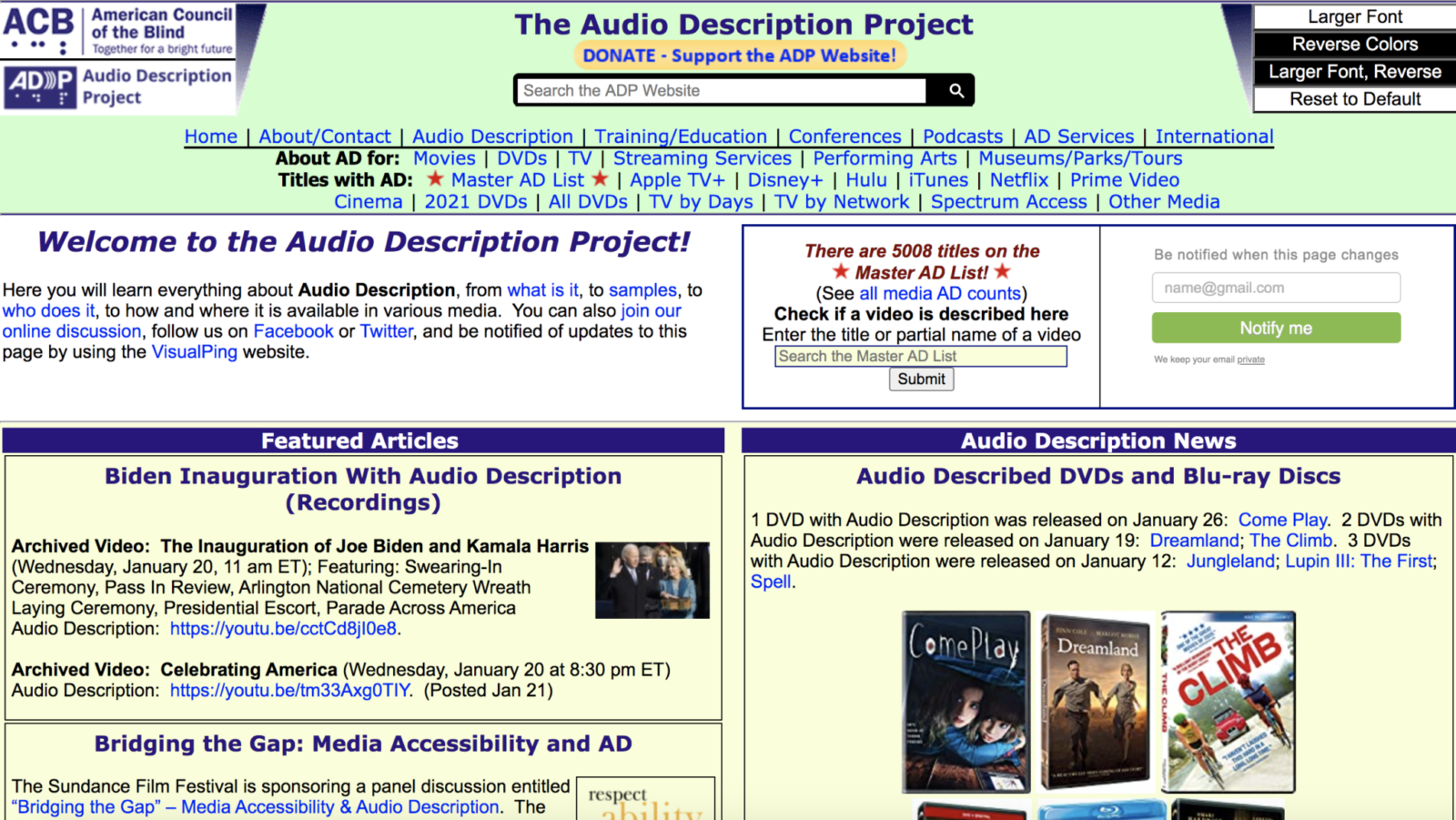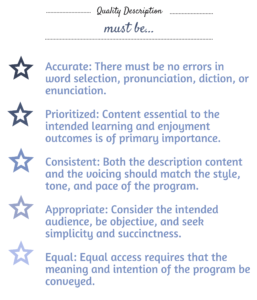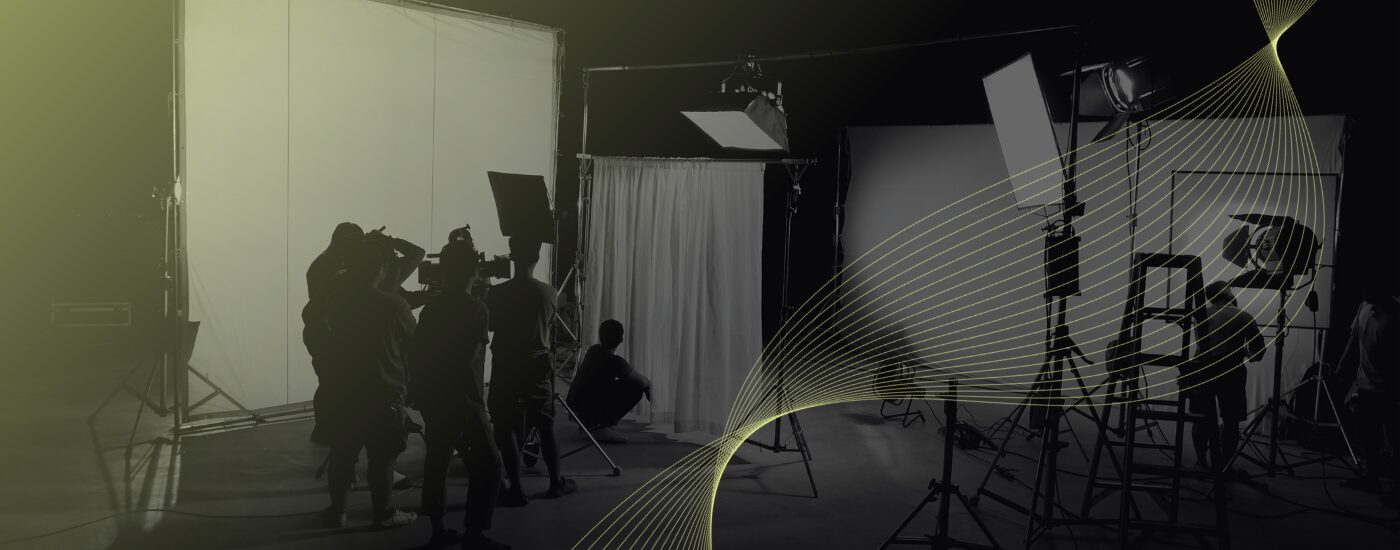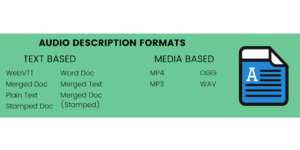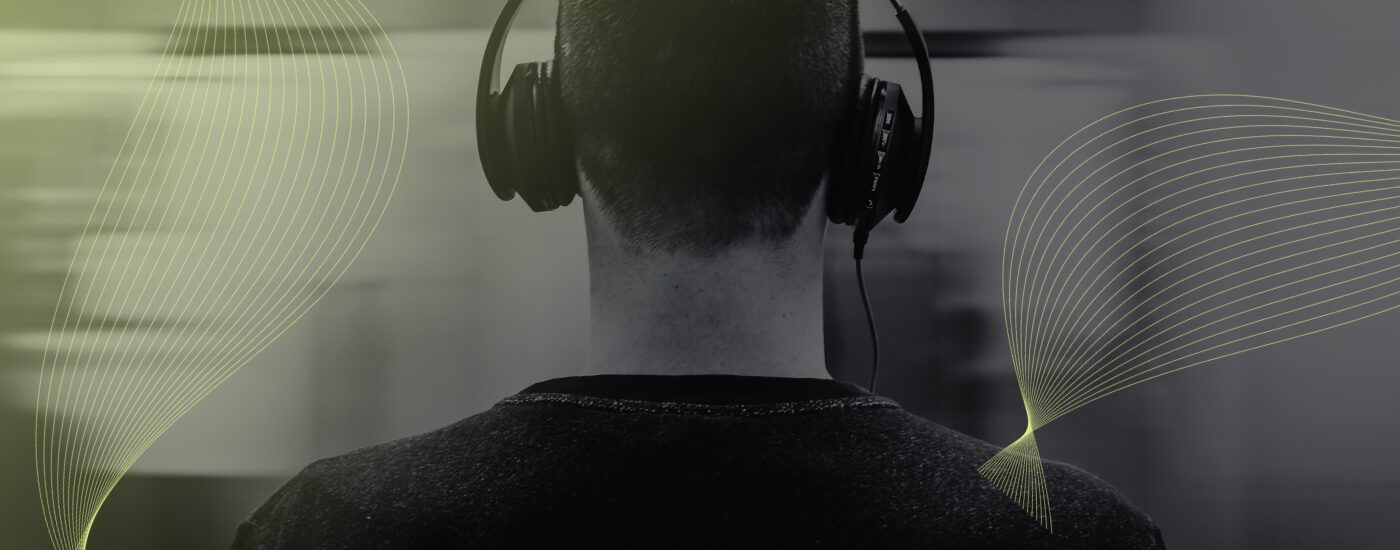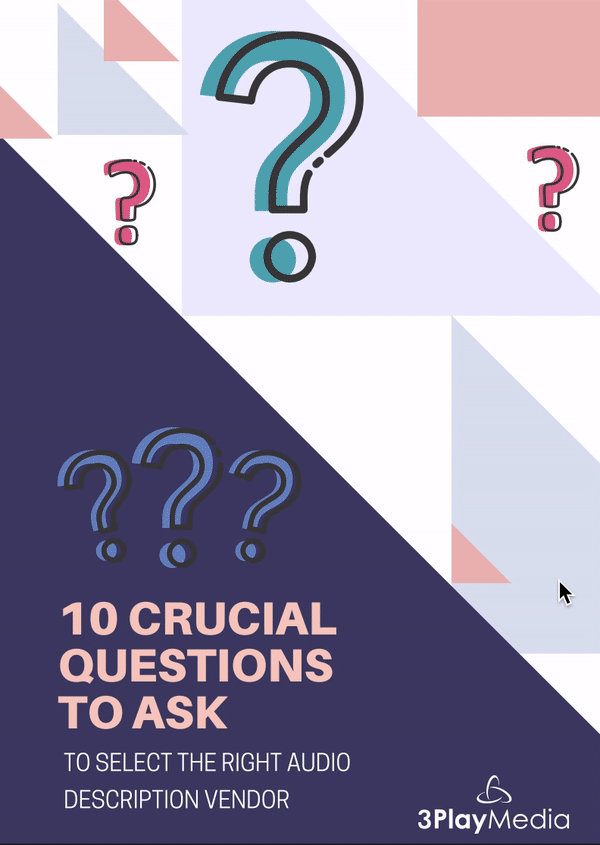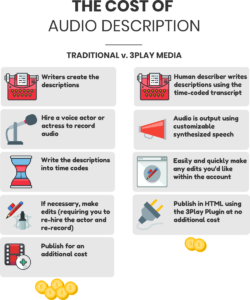Table of Contents
This guide has nearly all you need to know about audio description. From laws to best practices, it’s all here.
A Brief Introduction
History of Audio Description
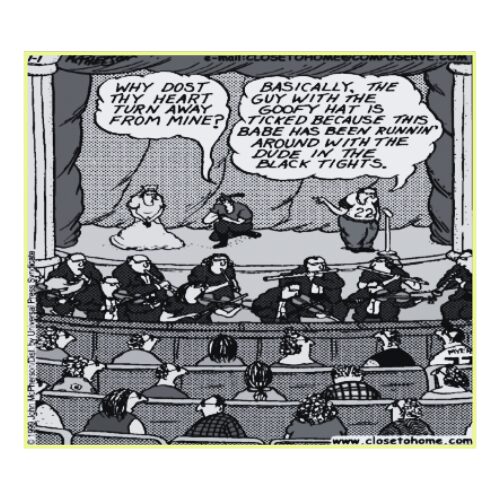
closetohome.com
Although it differs from the audio description we know today, the initial concepts of audio description were first developed in the 1970s by Gregory Frazier, a professor at San Francisco State University.
In the early 1980s, the Arena Stage collaborated with a group of accessibility advisors, including individuals from the Metropolitan Washington Ear, Inc., to develop an audio description program for its live performances.
In 1987, WGBH created Descriptive Video Services (DVS), a subsidiary that provides audio description for television viewers.
Audio description began to spread further within the museum field, then found its way into large format theater productions, exhibition tours, and planetarium programs across the country.
Today audio description continues to expand to DVDs, live TV, and online streaming services.
Video Stats
The stats on video trends today clue us in to why audio description continues to be a major accommodation and accessibility tool.
In the US, adults spend over 11 hours per day connected to media, with 6 of those hours spent watching video. 82% of the world’s internet traffic will be video by 2022. Not only is video consumption rapidly increasing, but our population is also aging, making vision loss an even greater public health concern.
The youngest of the baby boomers will hit age 65 by 2029. By 2030, the number of people over the age of 65 will be 20% of the population. With the risk of low vision and blindness increasing significantly with age, this has huge implications for the increase of vision loss over the next several decades. Currently, over 285 million people globally have some vision loss, of whom 39 million are blind.
What is Audio Description?
Many people take their sight for granted every day. We use our eyes all the time to learn, discover, and enjoy the world around us. We use our sight to help us navigate to different places, complete different tasks, do our jobs, and take care of ourselves. Take a second to think about what happens when you don’t have your sight to get you through the day-to-day. How do you enjoy simple things we have come to take for granted like videos and performances?
There is an accessibility tool for the blind and low vision called audio description. This tool is the key to revealing detailed information to blind and low vision viewers that their seeing counterparts consume without a second thought. Audio description strives to provide information on visual content that is considered crucial to the understanding of the program. For instance, it is used in cases where failing to provide these description would inhibit blind and visually impaired individuals from gaining a complete understanding of the given program.
Audio Description
Audio description is an audio track that narrates the relevant visual information in media. It assumes the viewer cannot see, depicting key visual elements necessary for understanding content as an accommodation for blind and low-vision viewers.
Extended Audio Description
Videos can vary quite a bit. TV shows will be different than movies, which will be different from training videos, music videos, and so on. One type of tool cannot be expected to always work for every video. That’s why there are two types of audio description – standard and extended.
Standard audio description allows snippets of narration to be interspersed within the natural pauses in dialogue of the original content. The descriptions must be kept concise enough to fit into the allotted time in order to ensure that they enhance the original piece rather than distract from it. Having overlapping audio tracks would make it very difficult to understand. This type of description works well for content with frequent pauses or a small amount of detail that needs to be described.
In some cases standard audio description is simply not suitable, and extended audio description may be a better option. Contrary to standard audio description, extended audio description is not constrained to the natural pauses of a video, but rather allows you to pause the original source content to make room for extended description, as needed. When utilizing extended audio description you will experience the video and description begin playing. Then, the source video pauses temporarily, while the description continues. After that portion of the description is complete, the video resumes playing again.
Standard v. Extended Audio Description
Extended audio description allows the source video to be paused to create room for lengthier descriptions when necessary. This is typically utilized when there are not significant pauses in the original content, or when there is a lot of key visual information that must be described.
How Do You Choose?
In simple terms, if your video has a lot of space to describe, standard audio description will meet your needs. If your video doesn’t have a lot of natural space to add narration snippets, extended is the way to go. While it may be easy to tell for certain files, for others it might be unclear. To help you determine which type of description is appropriate for your file, we’ve created a short quiz. Take a few minutes to discover what type of description your video could use!
The Many Names for Audio Description
Tomato, tamahto, potato potahto. What’s the difference between English descriptive audio, described video, and audio description? It’s not REALLY a trick question. English descriptive audio is simply another name used for audio description.
Similarly, both Described Video (DV) and Audio Description (AD) have generally the same function. They are both an audio track that narrates a program’s visual elements to make it more accessible to blind and low vision viewers. In each case, the description may include information about actions, characters, scene changes, surroundings, costumes, body language, and on-screen text, all of which help to describe the visual elements which are essential for comprehension.
While the terms are practically synonymous, each term is used in different parts of the world. This may seem like an unimportant distinction, but it is crucial to know what tool you are talking about, as audio description refers to two different things in the US and Canada. Despite the differing terms, both are crucial tools for video accessibility, and are required under several federal and local laws.
Canada is home to the most progressive accessibility law in the world – the Accessibility for Ontarians with Disabilities Act (AODA). The country also passed the Accessible Canada Act in May 2019 with the goal to create a barrier-free Canada by the year 2040.
In 2001, the Canadian Radio-television and Telecommunications Commission (CRTC) implemented requirements for audio description on specific programming by certain broadcasters. In 2009, it addressed the issue with a specific policy requiring DV for many programs, and to use the DV logo. More recently, the CRTC’s Let’s Talk TV initiative has resulted in a decision to further increase the availability of described video.
In the US, there are three major federal laws that impact audio description – The Rehabilitation Act of 1973, the Americans with Disabilities Act, and the 21st Century Communications and Video Accessibility Act.
Canadian Accessibility Laws
The Accessibility for Ontarians with Disabilities Act is the most progressive accessibility law in the world. It sets accessibility requirements for organizations in Ontario, Canada with the aim of creating a universally accessible province by 2025.
The country also passed the Accessible Canada Act in May 2019 with the goal to create a barrier-free Canada by the year 2040. This new accessibility legislation extends to all of Canada and provides a framework for employment, transportation, information and communication technologies, and more.
With 3.5% of the world’s population living with vision loss and blindness, audio description is a critical accommodations. As our society continues to consume a growing amount of video content, and our population continues to age, this accommodation will become increasingly important.
To make audio description more attainable, you may consider some of these innovative ways to approach English Descriptive Audio.
1. Technology
Traditional description requires human labor for the entire workflow. Once the description transcript is written, human voice actors are hired to record the description. This method is extremely costly and quite time-consuming. Yikes!
However, utilizing a combination of humans and technology can bring down the cost of audio description significantly and speed up turnaround time. In our workflow, certified human describers write high-quality descriptions, while advanced synthesized speech technology is used for the output. This option provides many benefits, including user control, more precise language, and faster production times. And, many blind and low vision viewers are accustomed to the more robotic output because they often use a screenreader that has a similar voice.
2. Describe while you go
You might consider this more of a way to avoid adding audio description, rather than a way to describe. Either way, this method is super cost-effective! If you are creating a talking-head video, simply be sure to include a lot of description during the initial recording so that you won’t have to go back in and add audio description in the post-production process. The recommended best practices for creating accessible video for blind and low-vision viewers include describing what is happening in the video as if you are recording a podcast or are on the radio, rather than taking a videotape. In other words, assume that all of your viewers are only listening, and not seeing the visuals. Remember to take pauses and leave room for any additional description when necessary, and always identify who is speaking and describe any participation or action from the audience or other members.
3. Write it all out
When in doubt, you can write it all out and create a text version of description. If you want to make this type of description more accessible, you can then create a time-coded text description, just like you would time code a caption file and use it to create a WebVTT. This will have to be read aloud by a screen reader.
Netflix Audio Description
Just like closed captions have universal benefits outside of accommodation, so do audio descriptions. In fact, people are discovering that audio description can be enjoyed by sighted people as a compliment and/or alternative to watching a video. Between dialogue, action sounds, and the soundtrack, audio description carries you through a video so that you don’t miss any details which are absolutely crucial to understanding the plot.
Have you ever found yourself trying to watch TV and cook dinner at the same time? Or maybe there’s a show you really want to watch and wish you could view it on your commute to work! Well you can listen to the audio description. Audio Description offers people the possibility of listening to their favorite shows and movies instead of watching them – even if that is in the car.
Want to try? Learn how to turn on AD:
A current list of Netflix titles that have audio description available can be found at netflix.com/browse/audio-description. Once you have decided which title you want to play, turning on audio description is simple. Once the video starts playing, click on the button at the bottom right hand corner of the video the same as you would for captions. Select the “English – Audio Description” option, and enjoy listening to your video play with description.
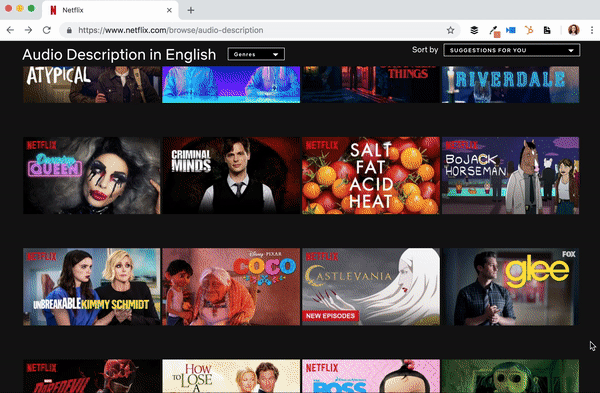
Audio Description Movies
Whether you need audio description as an accommodation or just want to try it out, you can find an up-to-date listing of movies available with audio description on the Audio Description Project website. Run by the American Council for the Blind, this site provides a comprehensive list of more than 5,008 described titles including cinema, DVD, TV, and more.
Benefits of Audio Description
- Accessibility: an accommodation for the 23.7 million Americans with visual impairments
- Autism: helps individuals on the autism spectrum understand emotional and social cues
- Flexibility: allows viewers to enjoy videos in eyes-free environments
- Language development: listening supports language learning and behavior association
- Auditory learners:20-30% of students retain information best through sound
- Inattentional blindness: highlights key visual elements that may be missed
- Legal: Required by law
You certainly don’t have to be blind or low vision to appreciate the many benefits of audio description. It’s true that the descriptive track was originally intended as an accommodation for blind and low vision viewers, but it has since proven to help many more. A few of those benefits include helping auditory learners better comprehend and understand information, helping those on the Autism spectrum to understand emotional cues, giving people flexibility to watch video in eyes-free environments, and pointing out visual elements that may have otherwise been missed. Plus, some people simply enjoy watching with the audio description turned on – talk about a full immersive experience!
People Are Turning Netflix Videos into “Audiobooks” with the Audio Description Feature https://t.co/H6UdlMzJFf
— American Council of the Blind (@acbnational) May 3, 2018
There are many different audio description examples. Listen below!
Close your eyes for a moment and imagine going through your day-to-day with your eyes closed. It would be very difficult to say the least! You might have difficulty understanding the morning news and getting the weather for the day, learning about traffic or delays on your morning commute, and then at work it would be difficult to navigate the Internet and understand the video being shown at the company training meeting.
Technology – specifically web and video – have become a major part of our daily lives in the US and around the world. Thus, it has become even more critical that this technology be accessible to everyone including those with vision loss.
Audio Description Laws
Providing accessible content is the right thing to do, but that’s not the only reason to do so. There are several anti-discrimination laws that require audio description in order to accommodate and offer access to blind and low vision individuals by providing audio cues. In the US there are three major accessibility laws that impact video, as well as web guidelines and standards.
→ The Americans with Disabilities Act (ADA)
The ADA is a broad anti-discrimination law in the United States. The ADA calls for "auxiliary aids" in communication. In the case of people who are blind or have low vision, this means that audio description must be provided. Title II of the ADA applies to public entities and Title III applies to places of public accommodation. Note: this includes online-only businesses like Netflix and Hulu, too.
→ The Rehabilitation Act
There are two sections of The Rehabilitation Act that impact video accessibility. Section 504 requires equal access for individuals with disabilities, which applies to federal & federally funded programs. Section 508 requires federal communications and information technology to be made accessible. Note: With the refresh, section 508 now references web content accessibility guidelines WCAG 2.0 which requires AD.
→ The 21st Century Communications and Video Accessibility Act (CVAA)
The 21st Century Communications and video Accessibility Act applies to any online video content that once aired on television at any point, requiring that it be made accessible to people with disabilities. The CVAA and Federal Communication Commission (FCC) has recently expanded audio description requirements into more TV markets, ultimately improving access to content for blind and low vision audiences.
ADA Title II Updates
The U.S. Department of Justice’s final rule on Title II of the Americans with Disabilities Act (ADA) mandates that public universities and community colleges ensure their digital content complies with the Web Content Accessibility Guidelines (WCAG) 2.1 Level AA standards. This includes providing captions for all pre-recorded and live video content, transcripts for audio-only content, and audio descriptions for pre-recorded videos. The rule was finalized in April 2024, took effect in June 2024, and sets compliance deadlines in 2026 and 2027, depending on the population size of the local government associated with the institution. Limited exceptions apply, such as for archived web content and preexisting social media posts, but password-protected content must also comply within 2-3 years of the rule’s publication.
Web Content Accessibility Guidelines (WCAG)
WCAG 2.0 is the international standard for web accessibility, and is referenced in several laws and lawsuits. WCAG 2.0 provides recommendations for making web content more accessible. Following these guidelines will make content accessible to a wider range of people with disabilities as well as all users. The WCAG requirements for audio description make content accessible for individuals who are blind and low vision.
Audio Description Lawsuits
Audio Description Lawsuits
There have been several major lawsuits and settlements regarding audio description including:
- ACB vs. Netflix settlement in which Netflix agreed to provide AD for many streaming titles by EOY 2016
- AMC Theaters was sued for failing to provide assistive audio description devices to blind viewers
- ACB vs. Hulu was sued for discriminating against blind and visually impaired by not providing audio description on movies or TV shows
- Hamilton was sued for violating Title III of the ADA by failing to provide AD
- DOJ vs. UC Berkeley letter where DOJ submitted a letter to US Berkeley that their MOOC content was inaccessible
Quality Standards
If you’ve ever seen YouTube automatic captions you know that caption quality can differ drastically. Bad captions are not helpful – and can actually be detrimental – as they provide incorrect information. To alleviate this, the FCC has requirements and quality standards for closed captioning. Similarly, audio description can vary greatly depending on who produced it and how. The DCMP description key provides comprehensive guidelines for how to describe. The description key outlines best practices and audio description standards that should be followed in order to create high quality description.
It’s important to have these standards, as providing the incorrect information is not only unfair, but does not meet the legal requirements to provide equal access to individuals with disabilities.
What to Describe
When describing, it is important to focus on what is essential for the listener to know in terms of plot development and character. For instance, this includes who is on-stage or on-screen, who is speaking, the setting and scene – including entrances and exits, furnishings, furniture, etc. – the lighting, costumes, facial expressions, movements, actions, mannerisms, gestures, fights, and dances.
Prioritization of what to describe is greatly dependent on the time allotted as well as how relevant and appropriate the information is in terms of the audience’s understanding of the content.
Remember that people are relying on the description to consume the content and your description should never be confusing or misleading, nor should it distract from the original source. High quality description enhances and complements the media to make it even better and easily understood.
How to Describe
The audio description project, an initiative of the American Council of the Blind, provides the following information regarding how to describe in terms of both language to use and style.
Language +
- Write simply, clearly and concisely so that the description is easy to comprehend.
- Use descriptive, accurate and appropriate language.
- Use complete sentences wherever possible, unless simply identifying a character.
- Match your vocabulary to the content.
- Avoid technical terms unless absolutely necessary.
- Beware of using he, or she, when this can be misleading.
- Do not use offensive or racist terms, (but do describe ethnicity where relevant), however, do not censor what you see.
- Work on expanding your vocabulary, especially verbs!
- Avoid the term “we see.”
- Be aware of what is real and what is illusion for your listeners.
Style +
- Never override the dialogue unless it is absolutely necessary. If you have to talk over the actors then do so over the least consequential dialogue.
- Describe what you see without interpretation or personal comment.
- Match your style, tone and pace to the show, scene or event you are describing or in other words, harmonize your delivery with the content of the presentation.
- Sound confident, interested, warm and authoritative. Be sensitive to the mood of the scene. Do not be patronising or chummy.
- Do not be tempted to fill every pause.
- Employ good microphone technique — no extraneous rustles, bumping the mic, varying your distance from the microphone, sudden unnecessary changes in volume etc.
- Describe at the same time as the action unfolds, or anticipate slightly, particularly with regard to comic or horrific situations to enable your listeners to experience the same emotions as the sighted audience at the same time.
- Describe in the present tense.
- Good description directs attention to the presentation, not to itself
Quality Description
Audio description is an accessibility tool growing in popularity. In addition to being an accommodation for blind and low vision viewers, it promotes a new way of learning through auditory means and can help individuals on the autism spectrum who may have difficulty recognizing emotional cues, who are learning English as a second language, or who have other learning difficulties. Others, simply like to use audio description as a different way to consume video content when they are not able to dedicate time to viewing the content, but would instead prefer to just listen.
The DCMP description key outlines several key elements for creating high quality description.
Audio Description Standards
The DCMP description key provides comprehensive guidelines for how to describe. Quality description must be accurate, prioritized, consistent, appropriate, and equal.
One of the major challenges with audio description is publishing it. While there are several ways to add audio description to your video, it is quite dependent on the media player capabilities, and not all devices or platforms have the same options.
According to international Web standards, there are several sufficient techniques for adding description to audio-visual material, all of which are reliable ways to meet the WCAG Success Criterion.
Ways to Publish Audio Description
- Add a user-selectable track that contains audio description. This is highly dependent on player ability, as most devices don’t allow you to use multiple tracks
- Publish a second version of the movie/video that contains audio description
- Provide a version of the movie/video that contains extended audio description
- Use a static text alternative to describe a talking head type video
- Use a WebVTT description track
Adding a second, user-selectable track
This option is highly dependent on media player capabilities, since most devices don’t have the capacity of merging multiple sound tracks. Adding a second, user-selectable soundtrack accommodates for that by providing an option which allows users to switch the original soundtrack with a new version of the soundtrack which contains additional audio description.
Providing a version with description
This approach adds the audio description to synchronized media by utilizing a second version of the movie where the original soundtrack and additional audio description are combined into a single track.
Providing a version with extended description
This approach involves providing a second version of video content with extended audio descriptions. This option alleviates the difficulty of trying to fit all of the relevant information into the natural pauses. This option could involve publishing a version of the movie with extended audio description and a version without description, or one version where the audio description can be turned on and off.
Using a static text alternative
Considered an alternative to audio description, this option is not suitable for all videos. It is best used for media that doesn’t have relevant time based information in the original video portion of the media. One possible use case is for a “talking head” video such as a press conference where an individual is speaking in front of a static background and there are no important visual elements to describe.
Using a WebVTT track
HTML5 video allows for the use of a WebVTT description file. Screen readers should be able to read this file, however, this is not supported widely across video players.
Publishing with the 3Play Plugin
If you are feeling overwhelmed by how to add audio description to your videos when you publish, the 3Play Plugin is the tool for you. The plugin is a simple iframe embed code that references your video and plays the secondary audio description track simultaneously along with your video. It’s simplicity makes it the perfect option for video players that don’t support audio description in a usable way, as well as a great alternative to having to create a second version of the video with description. Give it a try below and then get started. You can actually click on the “AD” icon to toggle audio description on and off. How cool is that!?
YouTube Audio Description
Adding audio description to your videos is critical for creating accessible content for many viewers. With over 500 hours of video uploaded to YouTube every minute, you definitely don’t want to be uploading content that isn’t accessible.
While YouTube, like other platforms, has begun to make it easy to add closed captions, it isn’t quite as easy to add descriptions. Most video players and platforms don’t support audio description the same way they support captions. The 3Play Plugin, however, allows you to easily add audio description to most videos without having to publish an entirely new video – including your YouTube videos. That means you have a better shot of YouTube’s 30+ million daily users checking out your videos.
Try it out:
Publishing audio description has traditionally posed a real challenge for people, as audio description is not supported by most video players and platforms. Providing audio description for your content – and thus making your content accessible – should not be a challenge.
One way to make the publishing of audio description easier is to have your audio description available in various different formats. This allows you to utilize the appropriate format to fit the player or platform where you want to publish. 3Play Media offers the ability to download different types of audio description formats, including several text-based and media-based formats to meet your every need.
Text-based assets are exactly what they sound like. These include the audio description in text form. You can download as a WebVTT, TXT, DOC, Merged TXT, Merged DOC, Stamped Doc, or Merged Doc (Stamped).
Text-based audio description formats provide the least amount of accommodation, as they tend to lose some of the cinematic detail compared with the media-based formats. Moreover, any of the non stamped files do not provide time codes which means that the audio description won’t necessarily associate with the correct timing of the original source content.
The text-only merged transcript and description are very helpful for deaf-blind viewers, as it contains both the transcript of the audio and your video, as well as the description of the visual information in your video.
Audio description only media assets only include the the audio description without the original source audio. This format can be downloaded as an MP3, OGG, or WAV. You can also download a mixed audio description asset which includes the description and the source media combined into one file. This format can be downloaded as an MP4, MP3, OGG, or WAV.
Audio Description Formats
- Text based formats include WebVTT, TXT, DOC, Merged TXT, Merged DOC, Stamped Doc, and Merged Doc (Stamped).
- Media based formats include MP4, MP3, OGG, or WAV.
How to Choose Your Description Service
When choosing an audio description vendor there are many different things to consider, including cost, quality, and available features. Depending on what you’re shopping for there may be several to many different variations to choose from. Finding a balance between cost, quality, and features takes some thought and research. Often you might discover that you get what you pay for with the lowest end option. All of this is true when selecting an audio description vendor as well. There are also certain things specific to audio description that you should keep in mind.
Our comprehensive checklist provides you with all the questions you should ask when searching for audio description services. Finding a vendor can be overwhelming, but remember the core things to consider:
Cost
Cost is at the forefront of most decisions, and audio description services are not any different. While cost should be highly considered before making a purchase, understanding a vendor’s process will help you gain insight into the value behind the cost.
The cost of audio description can vary greatly depending on different factors. For instance, a company that provides traditional audio description with human voice actors will be more expensive than one that uses technology or synthesized speech.
Quality
Whether you’re searching for audio description to avoid legal action or to assist blind and low vision viewers, quality is key! Choosing an audio description vendor that will provide high-quality descriptions ensures that your content will be both accessible and enjoyable for your viewers. The DCMP description key and general guidelines for how to describe outline several key elements for creating high quality description. These guidelines should be considered when looking for a vendor. Quality audio description must be accurate, prioritized, consistent, appropriate, and equal.
Features
Additional features are another important consideration for your audio description services. Being able to customize, edit, and easily publish your description can be a great challenge and expense. When selecting an audio description vendor, it would be wise to consider whether or not the vendor offers assistance for publishing, as well as the ability to customize and edit descriptions.
Audio Description Preview Window

Synthesized Speech and the Cost of Audio Description
Traditional audio description providers use humans for the entire workflow. In most cases, description writers create the description transcript, then human voice actors deliver the description. Voice talent is often quite expensive, making this method extremely costly and quite time-consuming.
Despite generally high prices, there are measures that can be taken to bring the cost of audio description down, and in doing so, make the service more widely available. One of the main ways to bring costs down is by taking advantage of current technology.
3Play Media is taking a new approach to audio description, using a combination of humans and technology in every step of the description process. By employing technology, we’re able to make the process of writing and time coding description easier, faster, and more cost-effective.
At 3Play, we use certified human describers to write high quality descriptions, then utilize synthesized speech to vocalize these descriptions. In addition, one of the hidden costs of audio description is the resource-intensive process of publishing audio description. Again utilizing technology, we’ve developed a plugin to alleviate the need to produce a second version of your video with audio description. Using a combination of human editing and advanced technology, the cost of audio description can be significantly decreased without sacrificing quality.





